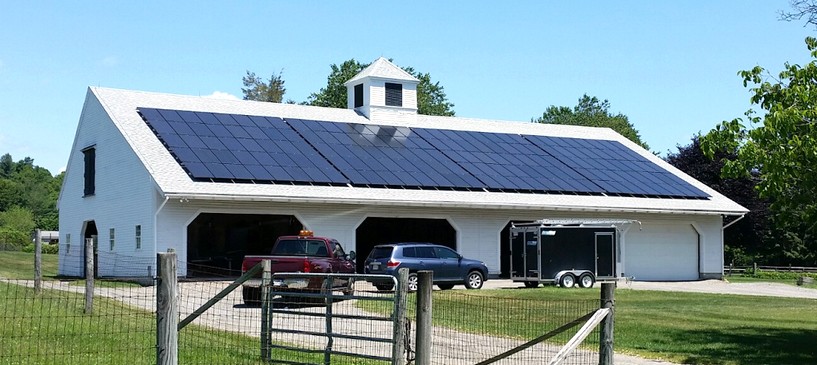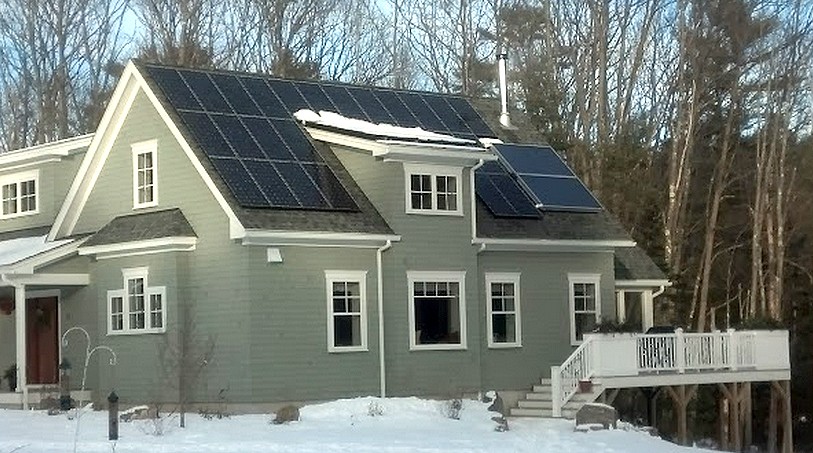The technology for grid-tied solar systems has changed rapidly since its start around the turn of the century. With many choices now available, it can be a bit confusing to decide which is right for you.
When solar electricity first became widely available, all of the inverters (the equipment to convert the DC voltage from a solar panel to the AC voltage that is needed to run the house) were string inverters. A string inverter has multiple solar panels wired in series, up to 600VDC, feeding into a single inverter installed inside the house, or in a protected outside location. If more panels are needed than can be wired in a series string of 600V or less, multiple strings are run in parallel. A string inverter is a great solution for a solar array that is all facing the same direction, at the same tilt angle, and with no shading issues. Remote monitoring of the whole solar array is available, but you can’t drill down to view the details of each specific solar panel. String inverters are the least expensive option.
The picture below shows a system with no shading or multiple angle issues, so a string inverter is a terrific option.
For the past several years, micro inverters have taken the grid-tied solar market by storm. The ability to monitor the system at the panel level, and more importantly, to have MPPT control over each individual panel instead of losing potential power in a whole string, or even the whole array due to the shading of a single solar panel, is hard to beat. The downside is having all of the delicate electronics outside at the solar panel for the life of the system in the extreme heat and cold. A specialized AC trunk cable is required to connect between the micro inverters. Having to run the AC voltage from the micro inverters at the solar array to the main breaker box at 240V means using larger gauge wire than if running at a higher DC voltage. It can be very easy to add onto a micro inverter system, as you only need to add another branch of additional panels and micro inverters. You don’t have to worry about your string inverter not being able to handle additional power. Micro inverters do come at a higher system cost than string inverters.
The next picture shows partial shading issues. As the sun comes across the sky, the dormer in the middle of the roof will shade the panels on its sides. The panels will be shaded on the west in the morning and on the east in the afternoon. Additionally, the snow buildup on the dormer can block the bottom of the panels above it. By handling the Multi Point Power Tracking (MPPT) at the individual solar panel level, shading from one panel won’t affect the output of the other panels, maximizing your array output.
The third option for inverters are also the newest technology, and have separated the inverter into two components; DC Optimizers and a string inverter. They are sort of a hybrid between the traditional string inverters and the micro inverters. A minimum amount of electronics is contained in the Optimizer, which is installed on the back of each solar panel, just like a micro inverter is. Except, the Optimizers do not convert the DC to AC, it keeps the output as DC. The Optimizers are wired in series for a higher DC voltage run back to the main string inverter, which is installed in a protected location.
The Optimizers do as the name implies, they optimize the output of each individual panel like micro inverters, so shading on one panel doesn’t negatively affect the output of the other panels. But unlike micro inverters, they leave the heavy work of converting from DC to AC to the string inverter, so much of the delicate electronics are more protected than being on the roof for decades. You are able to have monitoring of each panel through the optimizers, so you can immediately detect if a panel is heavily soiled or failing. The price for an optimizer system is generally right between a micro inverter system and a string inverter system.
Which solution is right for you depends on your site requirements, and how in depth you want your monitoring to be. If you have no shading and have no real need to monitor each and every panel, a string inverter could save you money on your system. If you do have a complex roof, or occasional shading, DC Optimizers may be right for you. If you are considering installing your system in phases, micro inverters may be the easiest solution.
For more details, you may want to check out our video on micro inverters, DC Optimizers, and String Inverters.



Hello,
Under the new bill prized by Governer Baker are only <10 kWh protected or are also <25wKh on three phase? I am confused on this point. Also, are pre-1,600 MW systems grandfathered under the old tariff or will net metering rates be reduced for them too?
I am considering a 24 MW system tied to three phase but want to net meter to other apartments. However, the new rules would change my plans.
Thanks, Mike
Mike, yes, under Gov. Baker’s proposal, under 25kW 3-phase systems will still be eligible for full net metering credit, just like under 10kW split phase. I’m not sure of the details of what would be grandfathered. I’m hoping once the legislature gets back to work, they will be working on a compromise bill, we’ll get more details then.